The archives
Return to the
Now spinning
page
Summer explorations
August 2006
27 August 2006
It happens to most handspinners sooner or later: free fleece. Sometimes it's a wonderful thing, with wool of excellent quality. And sometimes it's something else.
For the past several years, I've been lucky in wool. Wool I've purchased has been superb; wool I've been given has been truly lovely stuff. But my lucky streak shifted with the new moon last week: a co-worker returned from vacation and announced she'd brought me a fleece, "because my friend in the North just sheared her sheep, and they were going to throw all the wool away!" (warning sign, flashing bright)
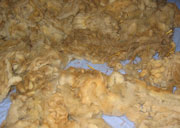
I thanked her, took the big bag home, and consumed two large cups of coffee while staring at the bag and wondering exactly what to do with it. It was pretty appalling stuff: unskirted, full of straw from the barn floor, impressively muddy -- in short, completely unpromising.
It's not clear just what kind of sheep my friend's friend has, but the wool was typical of that produced by a "meat" breed: sketchily defined locks; irregular, fine crimp; and fibers that are neither lustrous nor fine, but which don't have a lot of kemp. It's what's known as a "downy" fleece, not necessarily because it's soft, but because it's fuzzy.
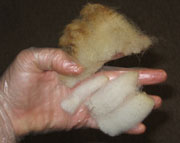
Even though the wool was very dirty, it was in good condition -- no breaks, very few second cuts, and not too much vegetal matter (that is, not much besides the straw from the barn floor). I decided to wash it.
(No, I'm not desperate to put more wool in my stash; but it had been a long time since I'd processed a "rustic" fleece, and it's a good thing to do now and then -- to be reminded that not all wool comes from handspinners' flocks, if nothing else.)
The sorting came first. I pulled the wool from the bag (and discovered it was not one fleece, but three) and endeavored to lay it out in "sheep shape" for sorting. To no avail: the fleece had been roughly handled and was in pieces. Never mind -- I put on my gloves and set to work. I was brutal: about 60% of the fleece went directly into the trash bag, either because it was too short (leg, belly, or neck wool), too full of straw, too kempy (probably from the "britch" area), or too full of clumps that seemed like "non-mud".
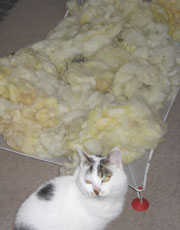
To wash it, I followed my normal wool routine: the fleece went into large mesh bags and was plunged (gently) into a bathtub full of very hot water with a generous dose of Dawn dish detergent. The water quickly resembled chocolate milk -- so I drained the tub, refilled it with very hot water and more Dawn, and let the wool soak again. That was followed by a hot rinse (another soaking process), a spin in the washer to get rid of excess water, and a final exit onto the sweater drying rack (left).
To my surprise, the wool cleaned up nicely -- or at least, much better than I'd thought it would. As it dried, though, it still showed unpromising variations in color (part of one fleece had a strong yellow stain, and some tips still looked suspiciously muddy); but the fiber was sound and pleasantly springy.
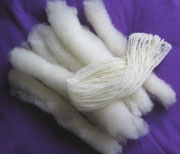
The small bit of remaining vegetal matter fell out readily as I teased the fibers, and the wool was very easy to process with handcards. The rolags are springy, fluffy, and oil-free.
Of course, I immediately grabbed a spindle to see how it would spin -- and it does very well! (right) That first skein is experimental; but this wool proved itself adequate for semi-worsted spinning and an excellent choice for spinning true woollen yarn. Plied, it would serve admirably in socks, mittens, or hats; spun true woollen, it could be used as a singles in blankets and throws.
The variations of color in the drying wool seemed to disappear once the fiber had been teased and carded; but processing wouldn't be enough to "fix" the yellow stain affecting a big part of the fleece. What to do?? --I decided to fight one stain with another (left).
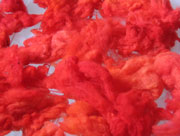
This batch of fleece was space-dyed with red and red-orange acid dye solutions (see the End Notes below for details). The variations in color are impishly subtle in the final wool -- just enough to keep things lively.
All in all, it was a pretty successful "rustic wool" experience! This wool will make another appearance very soon in a discussion of woollen spinning on the Articles page. Stay tuned!
End notes, for inquiring minds
♦ To space-dye the wool, it was first immersed in a cool vinegar-and-water bath in the dyepot, the liquid just deep enough to penetrate all the wool. With the wool fully wetted, the dye solution was poured in: red and red-orange dyes in irregular zones. I "smooshed" the dye gently into place, then let the whole thing batch at room temperature for several hours. After that batching period, I added enough water to bring the liquid to a "normal" dyebath depth, then simmered the pot for half an hour to set the dye.
♦ Acid dyes for this dye batch were purchased in powder form from Fibrecrafts in Surrey, England (click here for more information).
25 August 2006
My spinning this month has been running in parallel with a number of things. Not least among them: preparing for this year's Knitting and Stitching shows in the UK and Ireland (see the News snips page for more information).
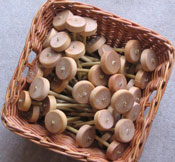
The photo at left shows the most time-consuming part of my preparations: learner's spindles for every student in my silk-spinning classes. Until the shows start, I won't know how many that will actually be -- but if all the classes fill, that will be 144 students, needing 144 spindles!
But aren't they pretty? There are 50 spindles in that basket, a quantity to accommodate one show's worth of classes, plus a handful of "extras".
17 August 2006
One conversation leads to another; and a recent conversation led me to order some "Italian silk waste" from my favorite fiber supplier. I had only a vague idea what the fiber might be like, but hey, any small baggie of fiber is worth it when the price is right -- right??
I'd seen "silk waste" fiber before. The nature of the stuff varies wildly from supplier to supplier. Sometimes it's made of the "blaze" that surrounds the cocoons; sometimes it's the starting and ending bits from the reeling process; sometimes it's neps and cocoon chunks, sometimes pieces of reeled silk, and sometimes actual threads.
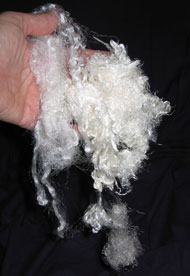
When this fiber arrived and I opened its baggie, it looked like the "mixed bag" kind of waste (left). It contains some lovely, extremely long fibers, some patches of fine reeled silk, some neps and chunks, and only an occasional bit of chrysalis. Pulled straight from the bag, it doesn't look promising -- but it's soft! The mix has been degummed, and despite its matted and chunky appearance, it has a nice hand.
Fiber in hand, it was decision time: what to do with it?? It could be blended with other things, of course. That would involve carding, because the short bits of fiber would be wasted if it were combed; however, because the long fibers were very, very long indeed (and very tangled!), carding would mean I'd need to cut them. There's nothing wrong with cutting fibers. People do it all the time. The silk fiber in lovely commercial tops has all been cut to a uniform length. But part of me sighs in disappointment whenever I get the scissors out, so I try to avoid cutting fibers when I can.
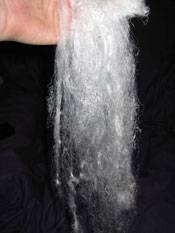
Whatever I was going to do, it certainly would have to start with teasing the fiber -- just to see what I had, if nothing else. The result (right) was nearly magical: teasing transformed the clumpy jumble into an airy cascade that wafted in the breeze. It was eminently spinnable, just like that. It's not a perfectly smooth preparation (if you click to look at the larger picture, you can see patches of the different fiber types), but its irregularity matches the joyfully varied nature of the "waste". A yarn spun directly from this teased mix would be textured and lively.
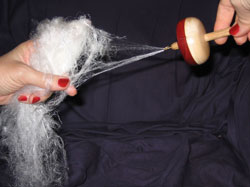
As usual, I grabbed a spindle for the first round of spinning (please excuse the nail polish -- those things happen sometimes). First snagging the edge of the fiber mass with the hook, I started out drafting without adding twist. To give you an idea just how long the long fibers actually are: in the picture, the hook has nabbed them at their midpoint and has pulled out less than half their length. This little exercise let me know exactly how big the drafting zone needed to be gave me an idea how the fiber would behave in spinning.
As spinning fell into a rhythm, the normal drafting zone for this silk waste turned out to be about two feet long. It had to be shortened occasionally, when the shorter reeled fibers came into the drafting triangle. The silk demanded careful attention (I like that!), but the fibers slid smoothly without being "slick", and except for their varying lengths were pretty easy to control.
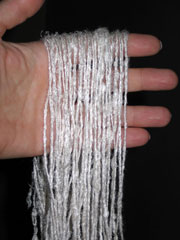
The final yarn is, indeed, lively and textured! It has eyelashes and nubs and bobbles, plus something I hadn't really expected: a lovely sheen. As a singles, it was charming; but its playful character blossoms after plying. As I wound the singles off in preparation for plying, I was surprised (again) by how well this silk behaves. It graciously forgives variations in twist, and even as a singles it stays calm and cool while you handle it.
To jump ahead to the second batch of this yarn: spinning this fiber on the wheel posed another, different challenge. Though the silk behaved just as nicely in drafting, the yarn tended to catch on the hooks as it wound onto the bobbin. But in the quest of such a playful yarn, a few interruptions to free snagged hooks are a small price to pay!
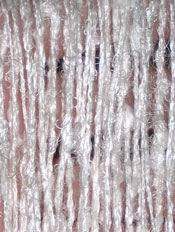
Photos don't communicate how a yarn feels in the hand, but if you click on the close-up view (right), you might get an idea of this yarn's character. It is soft and lustrous, and although its "eyelashes" look wiry, they're not; they're just a whisper of texture. The yarn is lightweight, but it has body. Its nubs and whiskers are all firmly anchored in place.
The yarn in these photos was cabled -- meaning it's a yarn made of two 2-ply yarns, plied together. The second batch of yarn from this fiber was a simple 2-ply, and except for its thickness, its appearance is identical to the yarn shown here.
End notes, for inquiring minds
♦ The spindle shown in the sampling photo was made by Spinner's Choice in Dundee, Oregon (click here for more information).
♦ The Italian silk waste fiber was purchased from Fibrecrafts in Surrey, England (click here for more information).
14 August 2006
The baggie is now empty: the blended camel down and silk is gone, and I'm left with a soft, shimmering skein of yarn that makes me wish I had more.
It was a delight to spin, from start to finish. The short camel down in the blend forced me to focus even more than usual on my drafting, which intensified the pleasure of watching yarn build up on the bobbin.
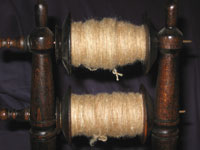
Normally when I spin a yarn destined for plying, I'll fill the bobbins less full than this, or I'll ply it on a different wheel; but because I had just this one baggie of fiber, and because it was such a delight to use the Haldane wheel to spin it -- well, I just kept spinning until the fiber was gone and didn't worry about it.
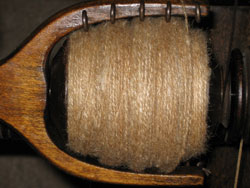
My cavalier attitude continued: I decided to ply the yarn on the same wheel -- meaning plying these two bobbins' worth onto a single bobbin of the same size. (Do you hear the ominous music yet?) The plying was pleasant enough at first; but as the bobbin filled, I started getting worried. There seemed to be an unending supply of singles on the bobbins of the lazy kate, and the wheel's bobbin was filling at an alarming rate. The plying continued, my anxiety increased, and the yarn piled up on the bobbin, closer and closer to the arms of the flyer....
Luck was with us that day: the yarn all fit on the bobbin -- just. That's an absolute-maximum bobbinful. It's stuffed. I don't think it could hold even one more yard.
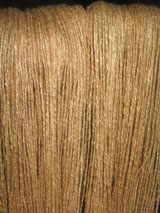
Whenever you spin yarn from a crimpy or downy fiber, you don't really know what you've got until after you've washed it. This yarn was no exception. Right after plying, fresh from the wheel, the yarn was lightweight and soft, the shimmer of its silk dampened a little by the matte camel down, but not too much. In the hand, the yarn looked much as it had on the bobbin: fairly uniform, with the camel down snugged smoothly in with the silk fibers. In short: a nice, comfortable yarn.
After washing (left), it graduated from nice to luxurious: the camel down "blossomed" into a warm-toned halo, with the silk providing a lustrous, pearly structure for the yarn. Looking at the skein at arm's length, the eye has trouble distinguishing the boundaries between silk and camel down. It looks like a skein of silk, but with warm shadows; and something about it invites you to bury your face in it. ...The washing, by the way, was nothing extraordinary: saturation in hand-warm water, then the yarn was squeezed out and hung to dry (unweighted).
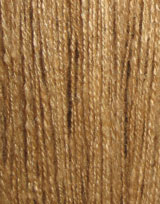
In the close-up view (right), you can clearly see the interplay between the two fibers in the yarn. Each plays its role perfectly. The camel down provides loft, warmth, and an inviting softness. The silk provides the structure, the sheen, and the elegantly light drape.
Many fiber blends are pretty or pleasing, but this blend is a successful cohabitation, in which each element enriches the other and coaxes it to new heights.
I just wish I had more of it!
06 August 2006
And now for something completely different: Housecleaning.
It started when I needed something from one of the stash baskets in the corner. That may sound like a quick rummage to some, but these are the stash baskets that haven't been un-stashed for about five years. Most spinners have one of those. I have more than one.
I no longer remember what I was originally looking for, because what tumbled out of the basket seemed like bouquets of letters from old friends: the dye experiments on a remarkably fine Romney fleece; the lusciously rich cashmere-wool-silk blend that came at a clearance price; little baggies of neps and sparkles and noils to be carded in with other fibers... and the final blow: shimmery fluff that grabbed my attention and shook it so hard that it forgot why I'd opened the basket in the first place.
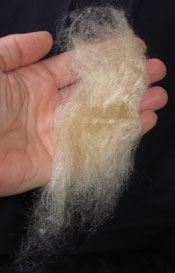
Look at it (left), gleaming there innocently. This is a blend of camel down and silk that was sent to me by a friend who disliked spinning it. I'd thought it was all gone, but one generous baggie had been waiting there in my basket all this time.... Heeding its call, I immediately oiled a wheel and set to work. And fell in love all over again.
Why, you may ask, would someone find this fiber anything less than luxuriantly, blissfully satisfying? The answer is that even though it's been beautifully blended, it's not all that straightforward to spin.
The fibers are of two very different lengths, and they respond to the twist in different ways. The camel down is fine and short, with a little springiness to it; the silk is high-quality tussah, smooth, sleek, and lustrous, with fibers ranging from two to three inches long.
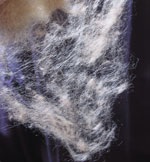
When the fibers are spread out and backlit (right) their differences show plainly: the camel down appears as little short puffs of fiber, while the longer silk meshes the combed fibers together. Even though this blend is as smooth and even as anyone could ask, the fibers' differences will unavoidably assert themselves as you spin.
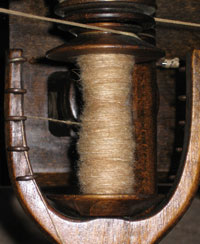
But it does spin -- and I do like it! Using a firmly-controlled drafting area and a fairly short draw, this blend makes a yarn that brings out the best of both fibers (left). The softness of the camel down and its warm, matte color are both deliciously present; and the tussah sparkle is unmistakable. The yarn is firmly twisted, and I plan to ply it; but even with the firm twist, its surface is pleasing and soft.
Spinning is a meditative activity, and it lends itself to the free association of ideas. That, in turn, leads to many things.
In the wake of a romp through the stash basket, those things are more likely than not to be yet more yarns. For evidence of that, take a look at what's on the spindle in the next picture.
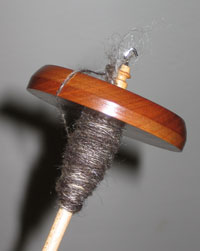
This is a "what happens if..." yarn, its fibers quickly blended with small hand cards and spun on the first empty spindle I could find. The fibers are yak down and tussah silk, roughly blended about half-and-half.
I like the way the deep color of the yak down makes the tussah shine silver instead of golden, and I love the contrast of its pale sheen with the matte darkness.
Something tells me a more formal blend of these two fibers is forthcoming! I think this yarn would be lovely in a fabric containing a companion yarn of camel down and silk.
End notes, for inquiring minds
♦ The wheel whose bobbin holds the camel-and-silk yarns is the Haldane "Lewis" wheel, shown elsewhere in these pages.
♦ The spindle in the yak-and-silk photograph was made by David Reed Smith (click here for more information).
♦ The yak down and tussah silk fibers blended for that test run both came from Fibreworks in Surrey, England (click here for more information).
01 August 2006
I have now plied the silk yarns from the past week's spinning sessions, and I'm absolutely delighted with the results! The yarn is cleanly defined, lightweight, floaty, and just textured enough to be lively.
Plying from quills (see the description in the last entry) has such a natural feel that I wonder why I haven't always done it! You hold the quills on a support so they can turn freely (two knitting needles work nicely), and you ply onto a spindle that's heavier than you'd normally grab for working with silk. The weight of the spindle as it drops pulls the strands of yarns together for plying. It's really, truly effortless!
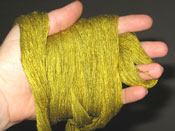
The skein in the photo (left) is "finished": it's been plied, then washed and allowed to air-dry, unweighted. It contains 180 yards of 2-ply yarn and weighs just 9 grams. Going through all the calculations, that means this yarn measures roughly 9000 yards per pound.
The photo doesn't do justice to the color, I'm afraid. In real life, it's a lively, shimmering golden chartreuse; but here on my monitor it looks like a drab gold. I love the way it looks in person, though, and I wish you could feel it: supple, floaty, almost ethereal. I'm hooked. I clearly need to spin more of these caps, because this yarn would weave up into a magically elegant wrap -- and I want to wear it!
It's fascinating to me that small changes in technique and slight variations in fiber (for example, spinning from hankies instead of from caps) can make such rich differences in the yarns.
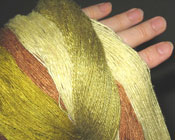
In the photo on the right, you can see some of these differences. Some of the silk is nearly matte; some is amazingly lustrous.
The colors have all come from my natural dyepot: onionskins, dandelion leaves, vinegar, and lime juice.
There's a lot to explore here -- and summer's not over yet!
31 July 2006
For the past week or so, I've been spinning silk caps. It's been hot here, and the caps are wonderful: not only do they considerately refrain from dropping things onto my summer-sticky skin, they require a big drafting zone, which makes me spread my arms -- and that exposes me to more cooling air from the fan. I'm spinning on a spindle with the windows open, and even though it's warm here, it's lovely.
Yesterday I rummaged through magazines and did some web-searching, and it looks as though most people spin caps by peeling off a layer, punching a hole in the middle of the cap's "peak", then stretching the fibers out into a thin, pre-drafted roving.
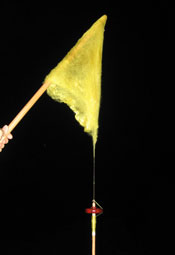
That's a perfectly viable method. But it's not what I'm doing.
I begin the same way: by peeling a layer of two or three cocoons' worth from the thick-ish cap that came from the supplier; but then I place that layer (essentially a thin cap itself) over a long distaff. This isn't a distaff attached to a wheel; it's a stick about a meter long that I've shaped to a rounded knob on the top end and tapered to a more slender thickness on the bottom. I can use it tucked under my arm, stuck into my belt, or held in my non-spinning hand.
To start drafting, I catch the edge of one of the fine layers with the spindle's hook and gently pull. When I've pulled out about a foot of fiber in a puffy strand not quite as thick as the spindle shaft, I add twist; and this becomes the "leader" to wind around the shaft.
Sharp eyes will notice that I've wrapped a small piece of paper around the spindle shaft as a sort of "quill". Silk from caps is more "grippy" than silk from combed top, and the quill helps slide the finished cop off the shaft at the end of spinning.
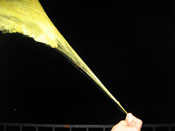
The drafting zone is fairly large. Because caps are made from cocoons stretched over a form, the fibers they contain are very long. They resist as you draft them. It's a nice feeling.
Drafting falls into a natural rhythm: draw out the fibers, twirl the spindle, draft more as the spindle spins, let the twist in as the spindle drops, draft more as the spindle spins, let the twist in -- and so on, until the spindle touches the floor. The length of the fibers is an advantage, not a challenge: it lets you dedicate one hand to holding the distaff, while the other handles the drafting and winding on. The yarn rarely drifts apart; its integrity is protected by the lovely, long fibers.
I'm planning to ply this yarn, so I'm putting a fair amount of twist into the singles; still, the rhythm is gentle and soothing. With such a large drafting triangle, I need to wait for the spindle sometimes -- but as I stand in the cool air between the fan and the window, that's not a problem.
One of the great pleasures for me in spinning these fibers is the way they feel as you draft them. I like their resistance. I like the fact that I need to pull against the firmness of the distaff to draw the fibers out. I love the rhythm of alternating between drafting and twist, between twist and winding-on, and between winding-on and letting the spindle drop anew. Those are the things that have been missing for me when I've spun from thin, pre-drafted rovings.
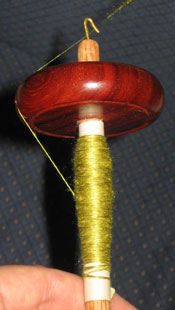
Spinning "stretched-cocoon" preparations like caps and hankies gives you a double reward: after the pleasures of spinning, you end up with a yarn that has both interesting texture and lovely sheen.
This summery yarn I'm spinning is drafted to be fine, and even though fine spinning makes for slow progress, the gradual build-up of yarn on the quill is beautiful and exciting. I can hardly wait to see how it will look when it's plied!
End notes, for inquiring minds
♦ The color in this silk comes from my kitchen: it was dyed with red onionskins, using alum as the mordant and white vinegar as the acidifying ingredient.
♦ The spindle in these photographs is from Spinner's Choice in Dundee, Oregon (see the Links page for more information).
Return to the Now spinning page